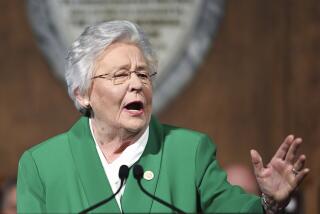Slight Membership Gain in State Fails to Brighten Outlook for Labor Unions
American unions last year enjoyed their first membership increase since 1994, and the vast majority of the gain came in California.
So, is the long-suffering U.S. labor movement finally recovering as an organizing force in the workplace, led by the trend-setting Golden State?
It doesn’t look that way. Newly released federal statistics show that organized labor still is drawing too few recruits in the private sector to overcome continuing membership losses in such areas as manufacturing, a traditional bastion of unionism.
The main reason national union membership edged up by 101,000 last year, reaching 16.2 million, is that employment expanded in the heavily unionized public sector. In California, for instance, the public sector accounted for 80,000 of the state’s 87,000 union members gained. Many of those new union jobs were teaching positions created by the state’s initiatives to reduce the size of school classes.
Trouble is, the public sector doesn’t offer much promise for future union membership increases. It already is highly unionized and, in most years, it isn’t a rapidly expanding area of the job market. “That’s not a growth sector, let’s face it,” said David A. Macpherson, an economist at Florida State University who studies union membership trends.
Another reason union membership rose last year is that, amid the nation’s continuing economic boom, both union and nonunion employers added lots of workers.
Even so, union employers apparently grew more slowly than nonunion companies. As a result, the percentage of workers belonging to unions across the country declined last year to 13.9%, off from 14.1% in 1997 and down from a high of around 35% in the 1950s.
California defied the trend somewhat, with its percentage of workers in unions inching up to 16.1%, from 16% in 1997.
Employers and organized labor critics say that many workers don’t want to join unions. They say many workers have been turned off by unions’ ineffectiveness and, in some cases, corruption.
Organized labor’s main weakness is its declining ability to win higher wages for its members, said Kenneth L. Deavers, chief economist for the Employment Policy Foundation, a Washington-based nonprofit group funded by Fortune 500 companies. He noted government figures showing that the wage premium for union workers has narrowed from 40% in 1983 to under 27% last year.
Kirk Adams, organizing director of the AFL-CIO, the umbrella organization for the nation’s labor movement, countered that the main problem for unions is that they devote too few resources to recruiting.
The AFL-CIO’s leaders--who will review recruiting, politics and other labor activities at their annual executive council meeting this week in Miami--have urged the federation’s 72 affiliate unions in recent years to devote 30% of their budgets to recruiting.
But Adams said only about eight major unions have either reached that target or committed themselves to doing so, and that at least 15 are needed to get there for the labor movement to achieve “significant” growth.
Labor leaders also blame the continuing weakness in recruiting on employers’ hard-nosed “union-busting” tactics. They cite illegal firings of union activists and legal maneuvers by employers that delay the adoption of union contracts for years.
Adams said that loopholes and light penalties under federal labor law make it “too easy for an employer to delay, impede or destroy an organizing effort.”
Still, he acknowledged, with a Republican-dominated Congress in Washington, “we’re not going to see any change any time soon” in labor legislation.
Ethics Initiatives Can Backfire
Workplace ethics programs can be hazardous--and not just to the people violating the corporate ethics codes.
A new study by the accounting and consulting firm Arthur Andersen found that some business ethics and compliance initiatives backfire and lead to shoddier conduct.
When employees believe that the programs exist solely to provide legal cover for senior management or to improve the company’s public relations image, “you end up with cynical employees” who take less care in their work, said Barbara Ley Toffler, the New York-based head of Arthur Andersen’s ethics and responsible business practices group. “It is worse than having no program at all.”
On the other hand, Toffler said, ethics and compliance efforts tend to succeed when employees sense that management takes business ethics seriously and treats workers fairly. One of the payoffs for the company, Toffler said, is that workers are more likely to report legal or ethics problems to their management rather than to turn to government regulators or the courts for help.
The Arthur Andersen study was based on the responses of more than 2,800 employees at six large U.S. companies with ethics and compliance programs.
*
Times staff writer Stuart Silverstein can be reached by phone at 213-237-7887 or by e-mail at stuart.silverstein@latimes.com.
More to Read
Sign up for Essential California
The most important California stories and recommendations in your inbox every morning.
You may occasionally receive promotional content from the Los Angeles Times.










